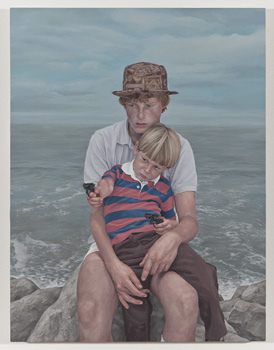
Opening September 10, 2011
In “Forget That You Were Young,” Christopher Murphy's current body of work, the conceptual and the representational are interwoven from found as well as family photographs that examine the nature of memory. Murphy is a talented painter whose previous bodies of work included full-length portraits, self portraits and studies of the buildings that populated the Brooklyn neighborhood where he resided in 2008-09. Back in Los Angeles (he was born in Irvine in 1977), his imagery shifts once again to embrace the open spaces — mountains as well as the ocean — of the California coastline. His works are not landscapes per se, but these regional locales serve as the backdrops for his narratives.
The works are concerned with dualities — the relationship between figure and ground, presence and absence, past and present, as well as the real and the imagined. He often begins with a photograph and selects specific people, settings and gestures from these snapshots, combining them to create the final work. The particulars of the photographic image — faded color, the direction and intensity of a gaze, random juxtapositions — are selected and isolated. Murphy is interested in what happens during the transforming of the decisive moment (the instantaneous nature of photography, particularly someone else's images) into something labored like an oil painting.
The exhibition carefully brings together paintings and drawings. While the paintings are richly textured and executed with exquisite detail, the drawings are sparse by intent. Murphy has a sense of humor and while the works are extremely serious, their titles offer a bit of reprieve. "Self Portrait as a Thug, Age Three" pictures two boys sitting on the rocks above the coastline. The younger one sitting in the lap of the older has a small gun in each hand and is aiming them cowboy style at an unknown target. The expression on the older boy's face is not one of terror or concern but rather of boredom. In "Future Vegetarian" Murphy depicts the rewards of a hunt. The contrasting modes of dress ranging from the formal to the casual in this image of four figures suggest that this is not a normal day at the water’s edge. In the painting a young boy dressed in a suit and tie holds the day's catch - a duck dangling from each hand. The young woman to his left is dressed as if she stepped out of the 1950s. On either side of this well dressed couple are casually and modernly dressed shooters. The four face forward, posing for the photograph as if it described a moment of celebration.
Murphy usually combines more than one painting style. While in the past this difference was at times quite drastic, in his current works the relationships are subtler. The figures are more impasto than the ground, and rather than solid fields of color the environments are also realistically rendered. It is in the drawings that the space around is often left intentionally vacant, creating an ambiguity in the work. For example in the triptych "Coolest Diver Ever" the red bathing suited, sunglasses wearing diver hovers above the diving board surrounded by white space and a few palm trees. The movement from board to air to pool is suggested by not only the placement of the trees but by the subtle lines that define the landscape. Murphy's graphite and acrylic drawings are beautifully rendered and it is clear that he knows what to define and what to suggest in each work. In "Grandpa Said We Could Dig A Hole to China" seven men dig a hole. A pile of dirt builds up to the right of the large pit they have created. The rest of the drawing is empty.
Murphy's rendering abilities, sense of composition and wit are just the entry points to the work. He clearly is making drawings and paintings about something. He researches the past, allowing it to merge with the present. Culling through archives of family photographs and combining them with images he finds in estate sales and thrift stores he invents narratives, compositing figures from disparate images to create new moments frozen in time. Murphy is trying to make paintings that resonate the same way photographic moments do and as such, is infusing his works with memory. Some are quite real and others total fabrications. Fantasy and reality merge in his dynamic surfaces.
Also on view are black and white photographs by photographer/writer Michael Gregg Michaud taken in the Rampart Division police station in Los Angeles. This historic area has undergone a tremendous transformation, and over the last fifteen years Michaud has documented not the cops but the young men who reside in the area. His black and white portraits convey the loss, loneliness and struggles facing urban youth in troubled economic times.
Published courtesy of ArtSceneCal ©2011
